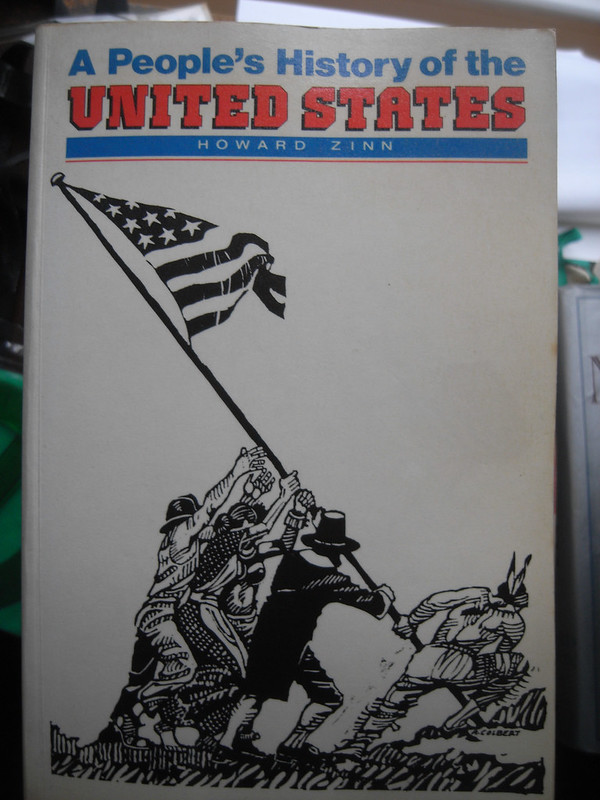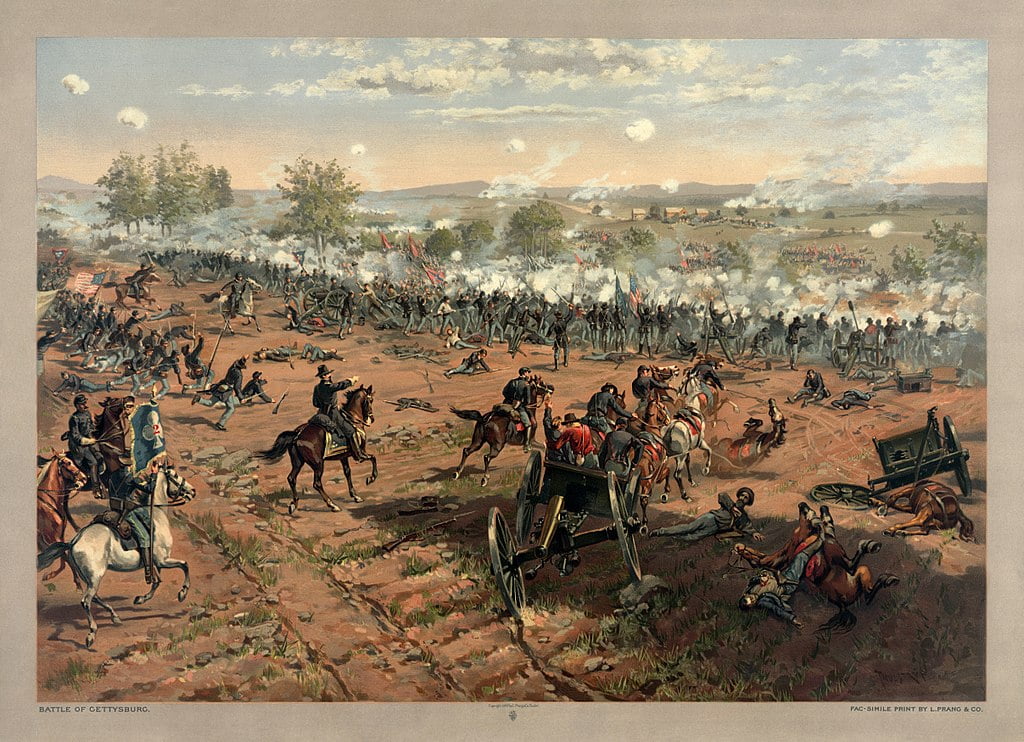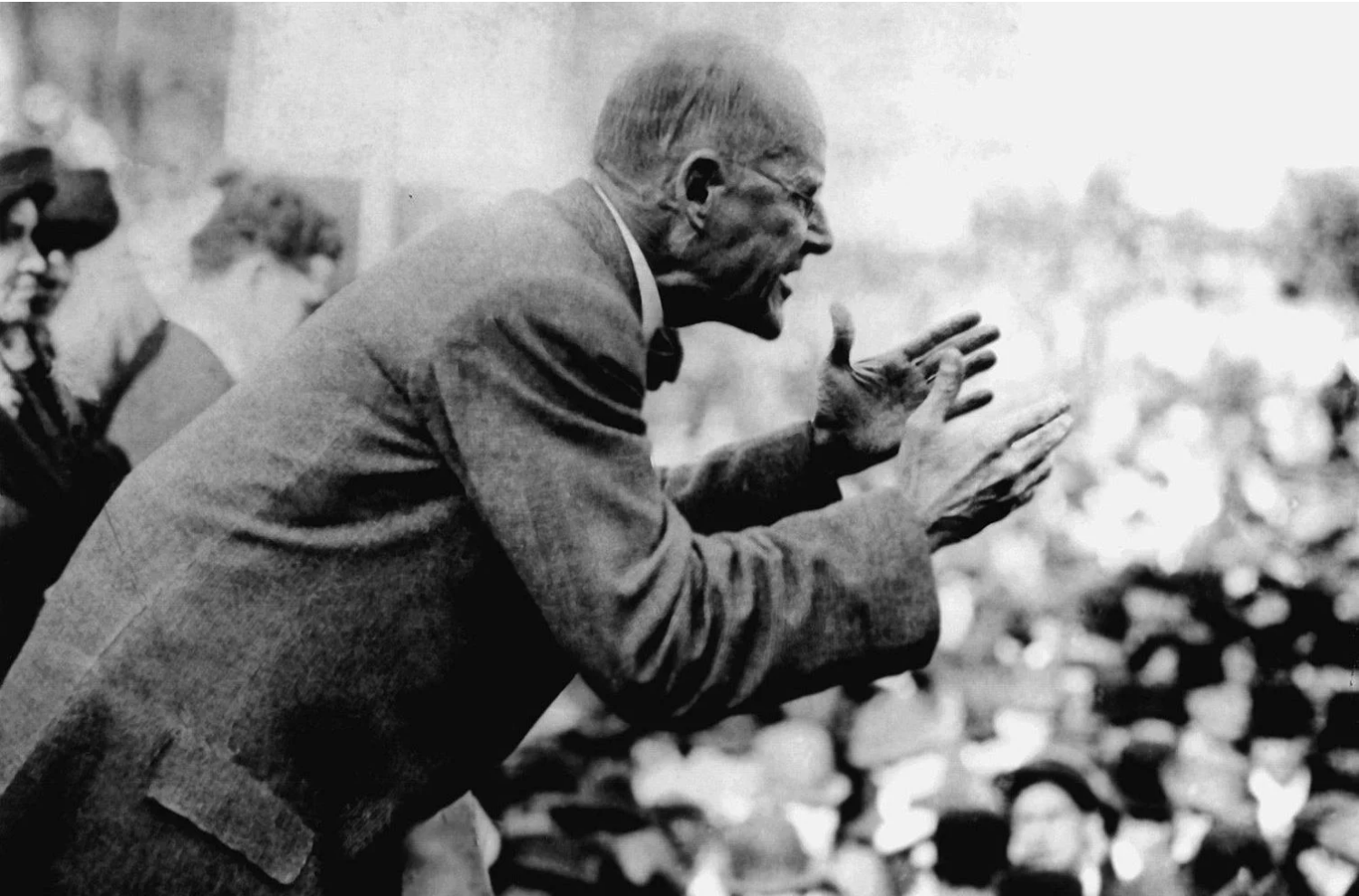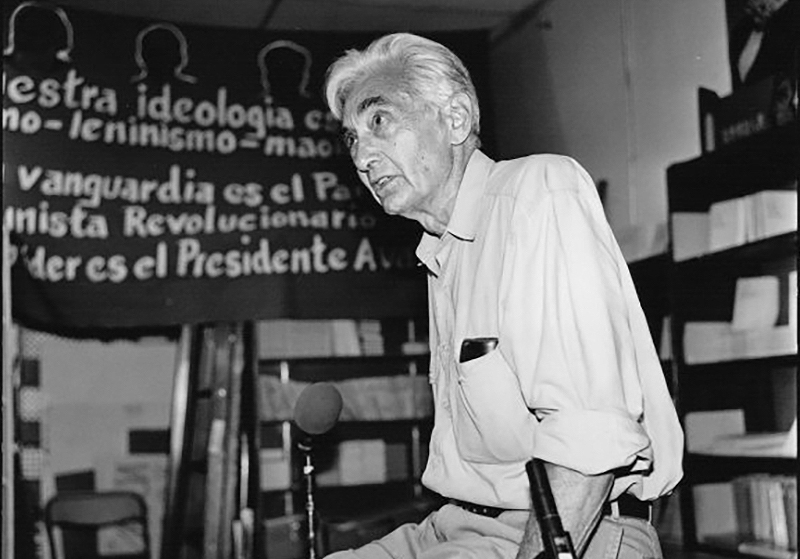Few books have received as much attention on the American left as Howard Zinn’s A People’s History of the United States. The son of two Jewish immigrant factory workers, Zinn dedicated himself to popularizing the many episodes in American history that have been distorted or ignored by mainstream bourgeois intellectuals. Above all, he took it upon himself to fight against the idea that only “great men” make history and instead explained history from the “bottom-up”—that is, from the perspective of the exploited and oppressed.
Published in 1980, A People’s History has sold over two million copies and still plays a role in exposing new generations to the atrocious crimes of the American ruling class over the last three centuries. As millions of America’s youth are radicalizing and looking to understand the country’s real history, A People’s History remains popular. However, while Zinn’s work has many positive aspects, Marxists must also look critically at this “standard textbook” of the American left and soberly evaluate its ideas, and above all, its method.
Centuries of bitter class struggle
A People’s History of the United States is a 700-page tome that covers the history of America from 1492 to the Iraq War. Zinn seeks to trace the history of “people’s struggles” against the rich and powerful. As he explains:
“We must not accept the memory of states as our own. Nations are not communities and never have been. The history of any country, presented as the history of a family, conceals fierce conflicts of interest (sometimes exploding, most often repressed) between conquerors and conquered, masters and slaves, capitalists and workers, dominators and dominated in race and sex. And in such a world of conflict, a world of victims and executioners, it is the job of thinking people, as Albert Camus suggested, not to be on the side of the executioners.”
A People’s History focuses on the many heroic struggles of the American masses throughout history. The great merit of Zinn’s book is that it cuts through American national myths and falsehoods. For example, one episode covered in the book is the American subjugation of the Philippines in 1899—an episode often ignored by bourgeois historians and rarely taught in schools.
 A People’s History focuses on the many heroic struggles of the American masses throughout history. The great merit of Zinn’s book is that it cuts through American national myths and falsehoods / Image: Steve Bowbrick, Flickr
A People’s History focuses on the many heroic struggles of the American masses throughout history. The great merit of Zinn’s book is that it cuts through American national myths and falsehoods / Image: Steve Bowbrick, Flickr
Following the Spanish-American War in 1898, the US sought to transform Spain’s former colonies into reliable markets for American goods. Immediately after the American occupation of the Philippines, the Filipino masses rose in revolt. The attempt to put down the insurgency quickly became an extermination campaign. Zinn quotes a captain from Kansas: “Caloocan was supposed to contain 17,000 inhabitants. The Twentieth Kansas swept through it, and now Caloocan contains not one living native.”
Zinn also quotes another officer recounting his experience in the war: “The major said that General Smith instructed him to kill and burn, and said that the more he killed and burned the better pleased he would be; that it was no time to take prisoners, and that he was to make Samar a howling wilderness. Major Waller asked General Smith to define the age limit for killing, and he replied, ‘Everything over ten.’”
The vilest nationalist and racist sentiments were inflamed to justify this barbarism. Only after three years and the use of 70,000 American soldiers was the Philippines firmly under the boot of American imperialism.
Countless heinous acts perpetrated by the American ruling class and its state are routinely hidden from view in classroom textbooks and ignored in university lecture halls. Zinn earned himself deep hatred from the ruling class for reminding the world of American capitalism’s crimes and the heroic efforts of the oppressed in their struggles for freedom.
Nonetheless, while A People’s History documents struggles such as Nat Turners’ Rebellion, the Arawak War, the St Louis Commune, and the rise of the Black Panther Party, as we shall see, Zinn’s work also contains significant flaws that deserve a balanced analysis.
Historical progress and morality
Zinn begins A People’s History by recounting the atrocities committed against the native peoples of Hispaniola, North, and South America in the 15th and 16th centuries. He recounts the most nefarious acts of genocide and ruthless exploitation by the Spanish and English colonizers in their search for gold, slaves, and land. As Zinn explains, the horrors of colonialism cannot be overstated:
“Total control led to total cruelty. The Spaniards’ thought nothing of knifing Indians by the tens and twenties and of cutting slices off them to test the sharpness of their blades. Las Casas tells how “two of these so-called Christians met two Indian boys one day, each carrying a parrot; they took the parrots and for fun beheaded the boys.””
![]() Building up the productive forces was a historically necessary stage in preparing the material conditions for socialism / Image: Rawpixel Ltd, Flickr
Building up the productive forces was a historically necessary stage in preparing the material conditions for socialism / Image: Rawpixel Ltd, Flickr
While today it is widely acknowledged that the colonization of North America was accomplished through the use of ruthless, genocidal violence, this was not always the case. When A People’s History was first published in 1980, most people were still under the impression that Columbus was a heroic explorer and the Pilgrims peacefully coexisted with the Wampanoag. This was no accident. To justify the rule of the American capitalist class, bourgeois historians intentionally painted this history as a smooth and painless process. Zinn’s book was one of the first significant works to confront this dishonest revision of the past, exposing history for what it really was.
Inseparable from the topic of colonization is the question of morality and historical progress, which Zinn approaches from a moralistic standpoint. As an example, capitalist development led inexorably to direct colonialism, a brutal and sadistic chapter of human history, the legacy of which continues to this day. However, Zinn sees this as “immoral” in the abstract. For Zinn, human progress is entirely relative and subjective: what is “progress” to one group of people is misery and death for another.
Marxists argue for a different conception of history and historical progress. Before humans can create art, science, philosophy, and culture in general, they must first feed, clothe, and shelter themselves. Therefore, in the final analysis, historical progress is that which leads to the further development of the means of producing the necessities of life for humanity as a whole—regardless of how much individual suffering that process entails.
Humans originally lived in small, classless, hunter-gatherer groups with an extremely low level of technique. As productivity rose over the millennia, society began to divide into antagonistic classes, giving rise to the state. Inequality, exploitation, and violence against the majority were inherent in this process. Nonetheless, this simultaneously freed up a small portion of society to develop science, technology, and productivity.
Despite its many crimes and bloodletting, the emergence of capitalism was immensely progressive due to its ability to revolutionize the means of production. Building up the productive forces was a historically necessary stage in preparing the material conditions for socialism. Socialism can be built only on the basis of large-scale industry and advanced technique. Only when poverty and material want are eliminated can classes, inequality, and the state begin to wither away.
Marxists have always acknowledged the ruthless violence and exploitation that was integral to capitalism’s development. As Marx put it, capitalism was born “dripping from head to foot, from every pore, with blood and dirt.” To be sure, the entire history of class society could well be classified as “immoral.” What society can claim to be moral when the necessities and pleasures of life are the monopoly of a select minority? Nonetheless, in our view, historical progress cannot be defined in a moralistic sense.
Marx—who had no sympathy for the American slavocracy—noted in The Poverty of Philosophy that without the colonization of North America, the creation of world trade, and the ruthless exploitation of Black slaves, capitalism would have been hamstrung: “Direct slavery is just as much the pivot of bourgeois industry as machinery, credits, etc. Without slavery, you have no cotton; without cotton, you have no modern industry. It is slavery that gave the colonies their value; it is the colonies that created world trade, and it is world trade that is the precondition of large-scale industry.”
Zinn’s methodological mistake in this regard has important implications. Lacking the method of historical materialism, he concludes that colonization, war, and all the other repugnant trappings of class society are just unhappy accidents that are best to be avoided. Whereas Marxists see an underlying thread of development in the history of class society, laying the conditions for the end of class society once and for all, Zinn sees only misery and violence in the abstract.
We might be horrified by history’s course of development, but that doesn’t change the fact that history has found no other means of building up the productive forces. As Trotsky remarked in Their Morals and Ours: “It is impossible not to agree with the moralists that history chooses grievous pathways. But what type of conclusion for practical activity is to be drawn from this?”
Our task is not to judge history, which does nothing to advance the struggle for socialism and freedom, but to understand its objective laws of development. As Trotsky explained, only with rational insight into the inner workings of the historical process can we seek to intervene in that process meaningfully.
America’s bourgeois revolutions
A large part of A People’s History deals with the American Revolution and the US Civil War. Zinn argues that while the two revolutions contained heroic elements of the “people” in their struggle for freedom, the leaders of the revolutions betrayed the masses and led to the establishment of a new powerful elite. As Zinn comments on the events of 1776:
“Were the Founding Fathers wise and just men trying to achieve a good balance? In fact, they did not want a balance, except one which kept things as they were, a balance among the dominant forces at that time. They certainly did not want an equal balance between slaves and masters, propertyless and property holders, Indians and white.”
 The US Civil War was ultimately a bourgeois revolution in its very essence and as such could go no further than the limits of capitalism / Image: Adam Cuerden, Wikimedia Commons
The US Civil War was ultimately a bourgeois revolution in its very essence and as such could go no further than the limits of capitalism / Image: Adam Cuerden, Wikimedia Commons
This assertion is undoubtedly correct. But without clearly situating the American Revolution in its proper historical context, it ends up missing the point. The economic foundation and class character of early American society were dramatically different from what it is today. The vast majority of the population was made up of poor and yeoman farmers, craftsmen, artisans, and slaves. The industrial working class was as yet in an embryonic phase of development.
Although it did not do the heavy lifting itself, the only class able to drive the development of the means of production at the time was the nascent American bourgeoisie. Despite the conservative nature of the “Founding Fathers,” the war for independence and revolutionary expropriation of the Tories’ property allowed for the rapid development of capitalism and, by extension, the development of the productive forces on a world scale. Therein lies the historical significance of the first American Revolution.
Similarly, with the Civil War, Zinn makes a repeated point of showing the limitations of the Union’s revolutionary struggle against the South:
“The clash was not over slavery as a moral institution—most Northerners did not care enough about slavery to make sacrifices for it, certainly not the sacrifice of war. It was not a clash of peoples… but of elites. The Northern elite wanted economic expansion—free land, free labor, a free market, a high protective tariff for manufacturers, a bank of the United States. The slave interests opposed all that; they saw Lincoln and the Republicans as making the continuation of their pleasant and prosperous way of life impossible in the future.”
It is undoubtedly true that the North made many mistakes and was initially reluctant to resort to revolutionary measures to defeat the South. Marx himself expressed his annoyance at the tepid measures taken by the American bourgeoisie, writing that “the manner in which the North wages war is only to be expected from a bourgeois republic, where fraud has so long reigned supreme.” (Marx to Engels, September 10, 1862).
Ultimately, Zinn misses the forest for the trees and is blind to the historic role of the Civil War in eliminating slavery and clearing the decks for today’s struggle for socialism. His moralistic view verges on the ahistorical, and he appears to see fully-fledged socialism behind every mass struggle, regardless of the objective limitations of the time.
The US Civil War was not a socialist revolution, and could not have been—the working class was far too weak and disorganized to be able to take power. To be sure, the struggle could have gone significantly further than it did, particularly during Reconstruction. But it was ultimately a bourgeois revolution in its very essence and as such could go no further than the limits of capitalism. As always, the material conditions ultimately determine the basic parameters and outcomes of revolutions—not our subjective desires.
The need for revolutionary leadership
A People’s History focuses on the multitude of struggles throughout American history but says very little about the leaders of such movements. One exception is the history of the Socialist Party of America (SP). Zinn describes the SP’s remarkable size and strength only a few years after its foundation in 1901:
“The party at one time had 100,000 members, and 1,200 officeholders in 340 municipalities. Its main newspaper, Appeal to Reason, for which Debs wrote, had half a million subscribers, and there were many other Socialist newspapers around the country, so that, all together, perhaps a million people read the Socialist press.”
 A workers’ party was badly needed in America at the turn of the 20th century. Eventually, several parties united in 1901 to form the Socialist Party of America. But the ideas underpinning the tactics, strategy, and overall goals of the party were not at all homogenous / Image: Public domain
A workers’ party was badly needed in America at the turn of the 20th century. Eventually, several parties united in 1901 to form the Socialist Party of America. But the ideas underpinning the tactics, strategy, and overall goals of the party were not at all homogenous / Image: Public domain
For the first time in history, the American working class had a party of its own, with hundreds of elected officials, daily papers, and leading positions in the labor movement. At its height, the SP was much larger than the Bolshevik Party was for most of its existence. On paper, the SP was in the perfect position to overthrow capitalism when the time was ripe. Yet this did not happen. Zinn’s conclusion is that beginning in 1919, the state successfully crushed the SP, causing it to descend into obscurity over the next 15 years. However, in the history of the worldwide labor movement, other workers’ organizations have successfully weathered severe state repression. So what really brought down the once-mighty Socialist Party?
A workers’ party was badly needed in America at the turn of the 20th century. Eventually, several parties united in 1901 to form the Socialist Party of America. But the ideas underpinning the tactics, strategy, and overall goals of the party were not at all homogenous. There was a strong reformist wing in the leadership, led by Victor Berger, which sought to dampen the revolutionary wing of the party, headed by Eugene V. Debs. Debs was a towering individual who made enormous contributions to the tradition of American socialism. However, he was not infallible, and during the clashes between the two wings inside the SP, Debs did not seek to combat the reformists on the question of theory and strategy. This turned out to be a fatal mistake.
The contradictions within the SP were bound to explode sooner or later. In 1919, under the hammer blows of international events—particularly the First World War and the Russian Revolution—the party split into three, with the revolutionary wing later forming the Communist Party of America.
Zinn presents the demise of the SP as a natural outcome of the harsh measures taken by the American state. While important, state suppression was only one factor—and certainly not the decisive one. The fundamental reason for the collapse of this impressive party was the unprincipled unity of reformism and revolution. Debs made the mistake of treating theory as a secondary matter. In reality, muddying the lines between reformism and revolution created fatal fault lines that shattered the party under the pressure of great events. The most important lesson to be drawn from this experience—the need for correct theory and bold leadership—is entirely missed by Zinn.
Zinn traces what the Socialist Party did, how many people voted for them, how many papers they published, and more. This is all of great interest, and there is much that socialists can learn from the experience. But Zinn’s “bottom-up” method of investigation—focusing on the “masses” and not on classes while relegating leaders and theory to the backburner—cannot explain why the SP was reduced to rubble without a single serious attempt at overthrowing capitalism. Without explaining this thoroughly and adequately, the main lessons from the history of the SP are lost.
Socialism: utopian and scientific
The original concluding chapter of A People’s History deals with Zinn’s perspectives on the coming American revolution. Here, Zinn shows his eclectic analysis of American capitalism and the possibility of socialist transformation.
Zinn begins by saying that the “American system” (capitalism) has been able to contain all the past “people’s rebellions.” Then, seeing that most Americans are not the superrich, he lumps together the 99% as “the people.” The “elite,” afraid of the 99%, then divides the “people” through artificial scarcity, nationalism, and prejudice. However, to explain the failure of past rebellions, Zinn discovers that the “people” are not so unified after all:
“In a highly developed society, the Establishment cannot survive without the obedience and loyalty of millions of people who are given small rewards to keep the system going: the soldiers and police, teachers and ministers, administrators and social workers, technicians and production workers, doctors, lawyers, nurses, transport and communications workers, garbagemen, and firemen. These people—the employed, the somewhat privileged—are drawn into alliance with the elite. They become the guards of the system, buffers between the upper and lower classes. If they stop obeying, the system falls.”
 To achieve victory in the future, the American working class requires what it never possessed in the past: a mass, class-independent revolutionary party grounded in the theory of Marxism / Image: Paul Stein, Wikimedia Commons
To achieve victory in the future, the American working class requires what it never possessed in the past: a mass, class-independent revolutionary party grounded in the theory of Marxism / Image: Paul Stein, Wikimedia Commons
Zinn now views the majority of the population—from lawyers to teachers to sanitation workers—as something akin to prison guards. In particular, Zinn points to “white workers, neither rich nor poor” as the main guards of the “American system.”
Zinn bases his understanding of classes on income and “privilege.” The “somewhat privileged” workers are considered “middle class,” even though they remain wage workers. At the same time, the 99% is lumped together as the “people,” despite the class differences within the “99%.” This betrays Zinn’s impressionistic approach to classes in society. In contrast, Marxism bases its understanding of class not on income but one’s relation to the means of production.
From this scientific approach, Marxists understand the working class as the only force able to transform society along socialist lines. This is not because the working class is especially oppressed or impoverished, but because of its particular social position and its role in modern industry. Instead, Zinn sees that some workers are better off than others and considers them a “middle class” buffer against the “lower classes.”
Zinn’s solution to this “American system” is to establish a “network of cooperatives… a neighborly socialism avoiding the class hierarchies of capitalism and the harsh dictatorships that have taken the name ‘socialist.’” To construct this “neighborly socialism,” people “would need to begin to transform their immediate environments… by a series of struggles against absentee authority, to give control of these places to the people who live and work there.” The methods of these struggles would “involve all the tactics used at various times in the past by people’s movements.”
As a result, Zinn’s book falls short in its practical solutions to the American working class’s problems. This gradualist approach and vague notion of cooperative-socialism is a form of utopian socialism. That is, the logic flows not from what exists in reality, but rather an idealized schema that originates in Zinn’s imagination. Classes are confused with income, the bourgeois state appears to be reformable, and most importantly, the role of leadership is completely ignored.
If all we do is repeat “all the tactics used at various times in the past,” we will simply repeat past failures. To achieve victory in the future, the American working class requires what it never possessed in the past: a mass, class-independent revolutionary party grounded in the theory of Marxism. Only then can the forms of struggle already discovered by the masses be put to good use in the struggle for a new and truly just society.
A question of method
A People’s History is a treasure trove of the endless capacity of the American masses to struggle in the face of hopeless odds and does an excellent job of transmitting knowledge of these heroic traditions to the next generation of class fighters. But the various problems highlighted above are all related to a philosophical error in Zinn’s general method. The method behind his book can best be described as empiricism combined with moralistic idealism. Facts are accumulated in vast numbers, but they remain isolated from one another. Their interconnections are lost in a forest of endless events, and theoretical generalizations remain dormant in the pile of factual raw material. The reader might well get the impression that history is, as Arnold Toynbee put it, “one damn fact after another.”
 As Marx explained “philosophers have always interpreted the world; the point, however, is to change it” / Image: Socialist Revolution
As Marx explained “philosophers have always interpreted the world; the point, however, is to change it” / Image: Socialist Revolution
In short, while Zinn’s book is an impressive compendium of events, the most critical question remains unanswered: why did all these movements fail? The empiricist method can state facts, but it is helpless to explain why events turned out the way they did. On the other hand, Zinn’s moralism is a brand of philosophical idealism, where Zinn projects subjective morality on history and creates abstract schemas for a future “neighborly socialism.” Empiricism and idealism are intertwined in an eclectic melange.
It would be a grave mistake to ignore the facts. But facts are not in themselves sufficient. A doctor, for example, must not merely catalog the symptoms of illnesses. Above all, it is necessary to understand diseases’ inner workings and how to treat them. Likewise, Marxism aims to understand history and society as a science, using empirical evidence to draw theoretical generalizations from historical experience. As Hegel said in his Introduction to the Philosophy of History: “It is, in fact, the wish for rational insight, not the ambition to amass a mere heap of acquisitions, that should be presupposed in every case as possessing the mind of the learner in the study of science.”
Marxists seek to gain scientific insight into the inner workings of history, economics, and the class struggle. But we don’t stop there. We don’t simply want to understand the world around us—we want to change it. Which philosophical method to adopt is not a sterile academic debate but determines our actions in the real world. Empiricism leads to an acceptance of appearances, while dialectical materialism, the philosophy of Marxism, allows us to penetrate the surface of events and even to anticipate events before they take us by surprise.
Our task is not merely to describe the past but to draw the necessary lessons from history and use it to fight for the socialist transformation of society. Marx explained this nearly 180 years ago when he wrote that “philosophers have always interpreted the world; the point, however, is to change it.” Let us do just that and put an end to this cruel system once and for all.
Originally published on 13 January 2022 at socialistrevolution.org |

